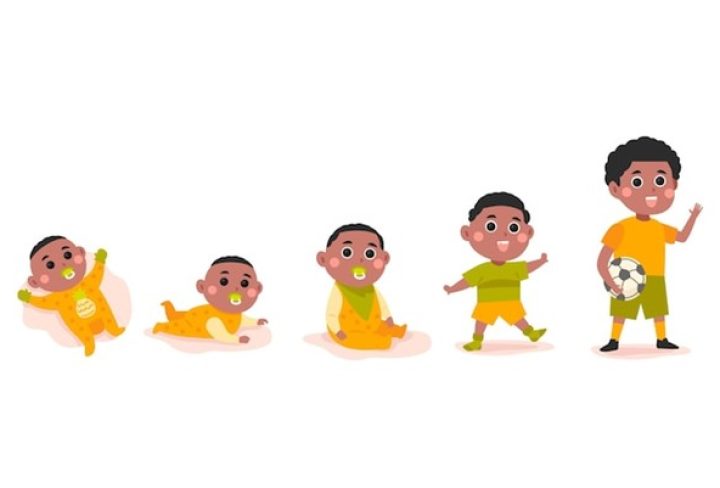Red Flag Signs: Birth to 3 Months
Physical Development:
• Lack of Head Control: By 3 months, your baby should start to hold their head up when lying on their stomach. If your baby’s head still flops back when pulled to a sitting position, consult your pediatrician.
• Stiff or Floppy Limbs: If your baby seems excessively stiff or floppy, it could indicate a neurological issue.
Social and Emotional Development:
• No Social Smile: By 2 months, your baby should begin to smile at people. If your baby doesn’t smile or show interest in social interactions, this could be a concern.
Communication and Language Development:
• No Response to Loud Sounds: Newborns should startle at loud sounds. If your baby doesn’t react to loud noises, it may be a sign of hearing problems.
• No Cooing or Babbling: By 2 months, your baby should start cooing and making gurgling sounds. Lack of these early vocalizations could be a concern.
Red Flag Signs: 4 to 6 Months
Physical Development:
• Poor Head Control: By 4 months, your baby should have good head control. If not, it may indicate a developmental delay.
• Inability to Roll Over: By 6 months, babies should start to roll over from tummy to back. If your baby isn’t rolling over, discuss this with your pediatrician.
Social and Emotional Development:
• Lack of Interest in Interactions: If your baby doesn’t seem to enjoy or show interest in interactions with caregivers, this could be a red flag.
Communication and Language Development:
• No Laughing or Squealing: By 4 months, your baby should start laughing and squealing. If these sounds are absent, it may indicate a delay.
Red Flag Signs: 7 to 12 Months
Physical Development:
• Not Sitting Without Support: By 8 months, your baby should sit without support. If they cannot, it may be a sign of delayed motor skills.
• No Crawling or Standing: By 12 months, most babies start to crawl and pull themselves to a standing position. If your baby isn’t showing these behaviors, it could be a concern.
Social and Emotional Development:
• No Stranger Anxiety: By 9 months, babies typically show stranger anxiety. Lack of this may indicate social or emotional delays.
Communication and Language Development:
• No Babbling: By 9 months, your baby should be babbling (“mama,” “baba”). If your baby isn’t babbling, it could indicate a language delay.
• No Gestures: By 12 months, babies should use gestures like waving or pointing. Absence of gestures may be a concern.
Red Flag Signs: 13 to 24 Months
Physical Development:
• Not Walking: By 18 months, your child should be walking independently. If not, this could indicate a motor delay.
• Poor Coordination: Frequent falling or difficulty with motor skills may be a sign of developmental issues.
Social and Emotional Development:
• No Interest in Playing with Others: By 18 months, your child should show interest in playing with others and engaging in simple pretend play.
Communication and Language Development:
• No Single Words: By 16 months, your child should say a few single words. If not, it may indicate a language delay.
• No Two-Word Phrases: By 24 months, your child should be using simple two-word phrases. Lack of this could be a concern.
Red Flag Signs: 25 to 36 Months
Physical Development:
• Difficulty with Fine Motor Skills: By 3 years, your child should be able to manipulate small objects, draw simple shapes, and use utensils. Difficulty in these areas may indicate a delay.
Social and Emotional Development:
• No Interest in Interactive Games: Lack of interest in interactive games or playing with peers by 3 years could be a red flag.
Communication and Language Development:
• Limited Vocabulary: By 3 years, your child should have a vocabulary of 200-300 words. A significantly smaller vocabulary could indicate a delay.
• Unclear Speech: While some speech errors are normal, speech that is difficult for family members to understand by 3 years may be a concern.
Red Flag Signs: 37 to 60 Months
Physical Development:
• Difficulty with Physical Activities: By 5 years, your child should be able to hop, skip, and jump. Struggling with these activities could indicate motor delays.
Social and Emotional Development:
• Inability to Follow Simple Instructions: By 4-5 years, your child should be able to follow simple instructions and routines. Difficulty in doing so may be a concern.
Communication and Language Development:
• Limited Social Interaction: By 5 years, children should engage in cooperative play and have friends. Lack of social interaction could indicate developmental issues.
• Poor Sentence Formation: By 4 years, your child should be able to form simple sentences. If they are still using only single words or very short phrases, this may be a red flag.
When to Seek Help
If you notice any of these red flag signs in your child’s development, it is important to seek help from your pediatrician. Early intervention can make a significant difference in your child’s development. Regular well-child visits provide an opportunity to discuss any concerns you may have about your child’s growth and development.
Conclusion
Monitoring your child’s growth and development is crucial for ensuring their overall health and well-being. This guide provides a comprehensive overview of red flag signs to watch for from birth to five years. If you have any concerns, please do not hesitate to contact your pediatrician for advice and support.
For more detailed information or personalized advice, visit our website or schedule an appointment with our pediatric team.

